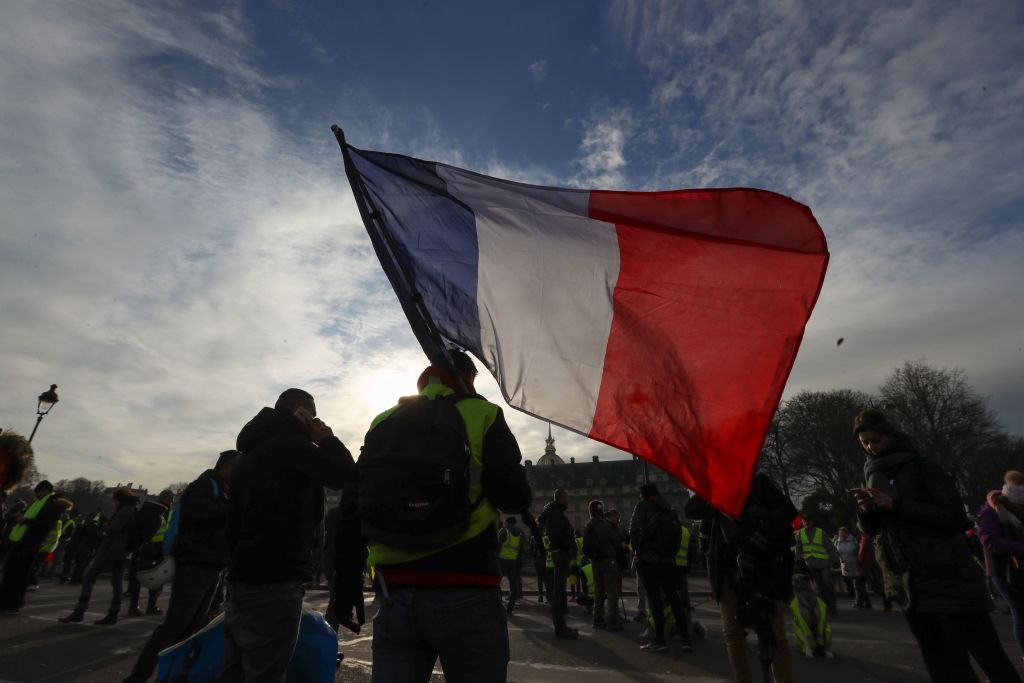As the European elections approach, Europe’s oldest liberal democracies – Britain and France – are in turmoil. Taking the long view, Britain’s problems are circumstantial and exceptional. France’s, by contrast, are renewing with more extreme political traditions that have risen and fallen, but never disappeared, over the last two centuries.
Gavin Mortimer’s blog on Coffee House describes the seemingly paradoxical synthesis of far-left and far-right voters contemplating casting their ballot for the same party – the former National Front, now Marine Le Pen’s Rassemblement National. Yet as with so much in French politics this is far from novel.
Karl Marx used nineteenth century France and its political history as a laboratory for his writings on class struggle. When he wrote famously that ‘history repeats itself; the first time as tragedy the second time as farce’, he was referring to the 1848 revolution tumbling into reaction with Louis-Napoleon Bonaparte’s coup d’état – just as the Great French Revolution of 1789 had spawned Napoleon Bonaparte, the former’s uncle. More importantly, he was touching on incipient patterns or traditions in French political history: the revolutionary and the reactionary.
All students of French and European history learn of the French revolutionary tradition, whose dates trip off the tongue: 1789, 1830, 1848, 1871, with near revolutions in 1936 or 1968. Some observers have tried to box today’s ‘yellow vest’ movement into that tradition.
But fewer students hear about the varied strands of the French reactionary or authoritarian tradition. Key illustrations of this would be Napoleon I, the 1814 restoration of an authoritarian monarchy, Louis-Napoleon’s 1851 coup d’état, 1940-44 Vichy and (less violently) Charles de Gaulle’s return to power in 1958.
Even less well known – and more controversial – is a French tradition dating from the 19th century that synthesises key elements of the two: an anti-system radical populist movement advocating direct democracy with socialistic overtones. This is combined with an authoritarian appeal to strong and charismatic leaders steeped in nationalism, often with more than a whiff of racism.
These protofascist beginnings were described by the Israeli historian Zeev Sternhell in a celebrated book ‘Neither Right nor Left: Fascist Ideology in France’, which was contested initially by French historians on intellectual grounds and doubtless because it painted France as the true birthplace of fascism, rather than Mussolini’s Italy. But the idea now has currency among mainstream historians.
The synthesis was first displayed in 1880s France in Boulangism, when movements of radical left and nationalist right provoked surprise by converging around the charismatic nationalist General Boulanger to win a host of parliamentary seats. It was given a sinister anti-Semitic turn in the following decade with the Dreyfus Affair, when the French army, state and courts falsified evidence and judicial procedure to prosecute an innocent and otherwise exemplary army captain for espionage really on the grounds that he was Jewish. Largely invisible for the next three decades, it raised its head again in the 1930s.
Extreme right movements gelled with the far left, linking nationalism and socialism to form French fascist ligues, which now aped the paraphernalia of Italian Fascist and German Nazi parties.
A former rising star of the French Communist party, Jacques Doriot, formed the fascist Parti Populaire Français, uniformed and black-shirted; and the leading socialist Marcel Déat created the fascist and uniformed Rassemblement National Populaire.
These leaders went on to become prominent ministers in the Vichy regime at the height of its collaborationist reign. The phenomenon rose again in the 1950s with the radically populist Poujadist movement. This was devoted to defending small shopkeepers, artisans and ordinary people against big business and an incipient Common Market. Marine Le Pen’s father, the founder of the French National Front, cut his teeth with the movement as one of its 52 MPs.
Now, according to recent opinion polls, an incipient synthesis is again underway. Jean-Luc Mélenchon’s far-left La France Insoumise (France Unbowed) voters are shifting to Marine Le Pen’s far-right Rassemblement National. This is symbolised by the defection of Andréa Kotarac, an important member of Mélenchon’s 2017 presidential campaign team.
Of course, some of this shift is attributable to tactical voting to block president Emmanuel Macron’s party at all costs. The Rassemblement National on 23.5 per cent is now running ahead of Macron’s list – but only by one per cent – while La France Insoumise is struggling at eight per cent.
Is it a question of stopping Macron at all costs or is the old Left-Right synthesis re-emerging? Le Pen’s party has a large working class following and populist left-wing policies to suit. So does La France Insoumise.
It might have been thought that the Rassemblement National’s nationalist stance would discourage internationalist France Insoumise voters, but both parties share a deep hostility to the European Union to the point of promoting Frexit policies in the 2017 presidential elections. Both are also popular with the Yellow Vests, whom Mélenchon portrayed as leading a ‘citizen’s revolution’.
Time will tell if the tradition of ‘neither left nor right’ is re-emerging. But if Macron’s party – devoted to a stronger, deeper, liberal Europe – comes second on 26 May, France’s turmoil will be given a new boost.
Professor John Keiger is a former research director in the Department of Politics and International Studies at the University of Cambridge






Comments